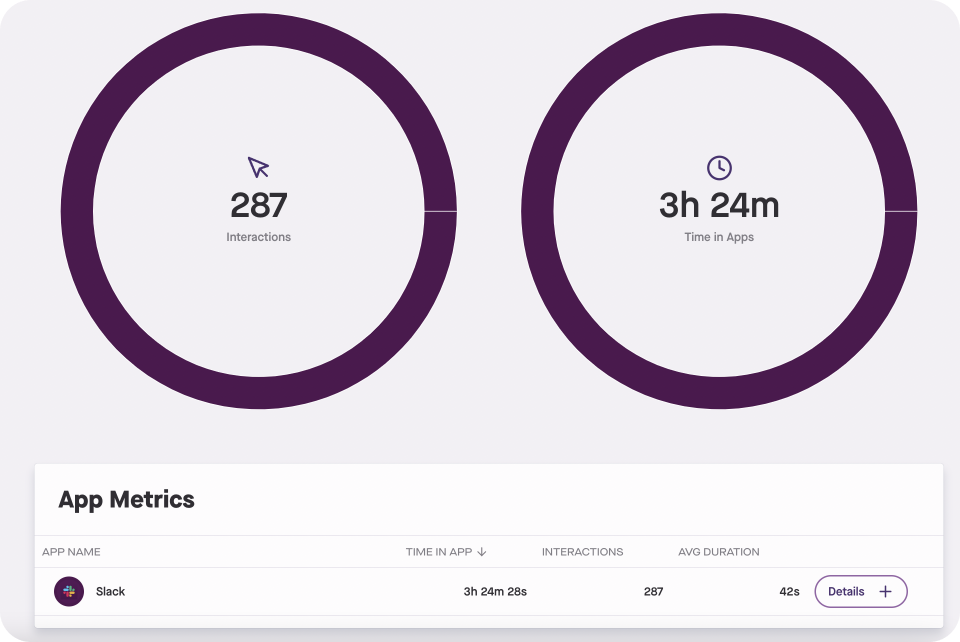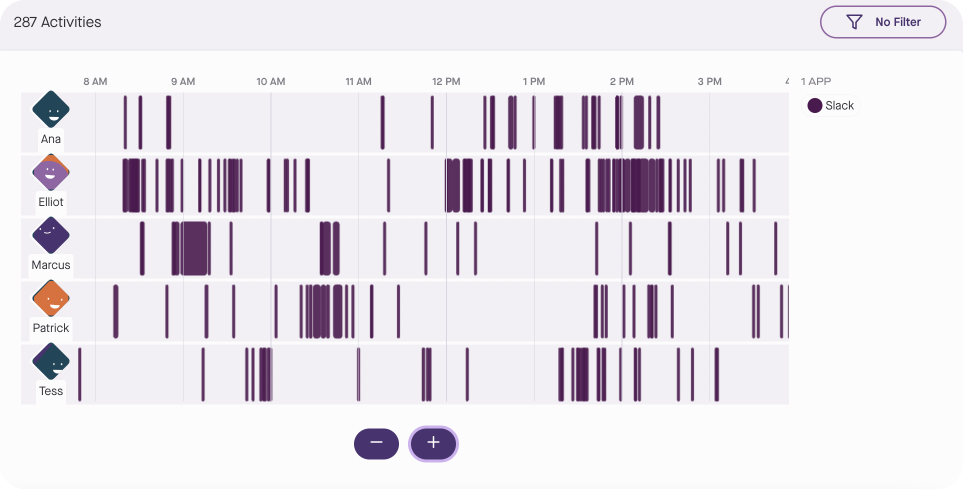Produce8
MSPs looking for the Produce8 Playbook, look no further!
Is Turning Off Slack Notifications Enough to Help You Focus?
We check Slack compulsively. Whenever a notification pops up, we give the app our immediate attention. We want to turn off our Slack notifications because the urge to read that message is overpowering.
Is it a colleague asking about something we’re familiar with? (A perfect chance to showcase our knowledge!)
Or perhaps it's our manager seeking a quick conversation? (Cue the stress!)
We remain active on Slack and other messaging apps so we can respond to our teammates right away and avoid missing out on important information. Even when we have other work to do, we prioritize Slack.
For many of us, the workday can feel like a continuous cycle of distractions initiated by Slack notifications. Forget about focus—we can’t think of anything else until we clear that pesky red dot.
According to Gitnux, the average Slack user checks their account 22 times per hour and sends a total of 70 messages per day. And there is a strong possibility that a significant number of those interactions are triggered by notifications that don’t require responses. Is that good collaboration? Is that productive? The science of context switching tells us it isn’t.
Still, everyone's work habits are different. How can we silence Slack notifications without disrupting workflow? To differentiate between productive work in Slack versus interruptions, we need more data.
The Produce8 team relies heavily on Slack. And when we want to check whether our Slack usage is effective on a given day, we take a look at our Workspaces in Produce8 .
Take this day for example:

We noticed that our team of five interacted with Slack 287 times with the average duration lasting 42 seconds.
Why are interactions and average duration metrics important?
If we have a high number of interactions with a short average duration, that means most interactions weren’t meaningful. They were quick checks as opposed to intentional work. These little cuts in our days add up to minutes and hours lost.

This is what we’re here to address. While work does happen in Slack, we want to reduce the number of reflexive and spontaneous interactions triggered by notifications.
Individual productivity hacks don’t work
Leaders commonly suggest that their team should mute Slack so they can focus on their work.
But does turning off alerts actually help us perform better? Or does it cause us to miss time-sensitive information, resulting in bottlenecks and delays for the rest of the team?
The truth is that being completely unreachable on Slack for hours of the workday is not possible for most employees. That’s why telling someone to mute Slack won't necessarily fix anything.
But hope is not lost. In this article, we discuss how to turn off Slack notifications, acquire insights to inform our teams, and recover time for focus work without compromising collaboration.
1. Measure your Slack usage baseline:
Let’s start with some simple questions.
On a given day …
- How many times do you interact with Slack?
- How long are you in the app for?
- Do you check it and then leave? Or are you highly active?
- How many critical conversations are you involved in?
- How often do non-urgent notifications take you away from your work?
Don’t know?
Well, before you can experiment with your Slack usage, you must establish a baseline of how you’re using the collaboration app.
A tool like Produce8 can show you data that represents your time in Slack, your average duration, and the number of interactions you have.
2. Analyze the data:
Once you have Slack set up in Produce8, you’ll gain a full picture of your workday.
For the first week or two, continue working in your typical manner. (For instance, keep your Slack notifications turned on if that’s what you’re used to.) This allows you to accumulate data and gain an understanding of your work habits.
Afterward, examine the results and see if Slack is truly interrupting your focus time.
This is an example of my recent Thursday:


I had 127 interactions with Slack and an average duration of 25 seconds. That’s not great.
And sure, that’s just one example from one day. But if I notice it becoming a pattern, then it’s worth experimenting with Slack configurations (such as turning off notifications) to help regain focus.
3. Share with your team:
Once you have analyzed the baseline and established quantifiable data that shows you are being pulled away from work due to Slack, share these findings with your team. Because a Slack problem is a team-based problem, being transparent about individual initiatives ensures there are no confusing mishaps, no disruptions to the workflow, and no surprises.
In this way, you can also assess how big the problem might be for your team.
Here is how you can approach sharing your data:
- Let them know that Slack notifications are distracting you from your work and, as a result, causing you to be less effective in your primary task.
- Explain that constant context switching diminishes the quality and relevance of your responses in Slack.
- Show them the Timeline of your workday and point to all the little distractions Slack causes.
- Address the key metrics you’re evaluating: reducing interactions and increasing average durations.
- Tell them that you will be running an experiment to increase your level of focus by muting Slack for the next two weeks.
- Give them a window during the workday in which you will be available on Slack to answer messages in batches. Emphasize that outside of that timeframe, immediate responses may not be possible.
- Invite them to use Produce8 to analyze their baseline.
Once you have a team understanding, you are ready to run the experiment.
4. Make a hypothesis:
A well-thought-out hypothesis helps shape your experiment to determine whether muting Slack notifications actually improves focus time.
Here is an example of a hypothesis for such an experiment: By decreasing my interactions with Slack, I will have more dedicated focus time to commit to my work.
5. Turn down Slack notifications:
Now that everything is in place, it’s time to turn Slack notifications off. But the thing about Slack is that it has many notification features and many ways to steal your attention. We recommend turning off all notifications. As you experiment, you can test turning certain ones back on.
Want to know all the ways to turn off your Slack notifications? Check out Slack’s handy guide .
6. Start working with Slack muted:
Now that your team is aware of your reduced presence in the messaging app and the experiment is in motion, you can resume your work with Slack muted.
During this phase, be kind to yourself if you occasionally slip up. Breaking old habits is challenging. It will take time and dedication.
Remember, every instance provides valuable data that will contribute to building strategies for long-term improvement in your workflow.
7. Measure results:
We suggest reviewing the results of your experiment after two work weeks and documenting your findings by comparing them to your initial benchmark.
Let’s look at my example again.


I saw a decrease in interactions from 127 to 78 and an increase in my average duration from 25 seconds to 35 seconds. That’s not a dramatic change, but it is a good indicator that my Slack usage is trending in a positive, more focused direction.
Use your data from Produce8 to validate your hypothesis. Has muting Slack altered your work habits? Do you observe a positive difference?
Based on these observations, consider whether it is worthwhile to continue with this approach, revert back to previous work patterns, or explore new experiments.
For me, I’d say it’s worth continuing to have notifications turned off. I’d also like to experiment with other Slack configurations. I have a theory that notifications alone aren’t the cause of my short average durations, but there is only one way to find out.
8. Share findings with your team and invite them to join the study
Remember, Slack serves as a collaboration tool. When engaging in collaborative efforts, it is valuable to involve the team in the discussion. Share the results of your experiment and talk about your conclusions.
Slack is a tool used by the entire team. So, if it proves to be a distraction for you, it is likely affecting others as well. Extend an invitation to your team to join Produce8 , where they can explore and experiment with their own Slack usage. This will enable them to gain a deeper understanding of their work habits and determine if adjustments can be made to enhance focus.
While Slack is a wonderful tool for collaboration and communication, it is also super noisy. If left unchecked, it has the potential to consume a significant portion of your day. Whenever you feel like you don’t have enough time in the day to complete your work, we recommend looking at how your top collaboration tools are being used and whether they're working for or against you.
For more details about running your experiment, please check out our Produce8 + Slack Playbook .
Related Aritcles
Digital Work Analytics reporting
AIRO Part 4 - From Reactive IT to Managed AI - The Next Evolution for MSPs
2 min read
Unlock great workdays
Wether you are collaborating with your team or solo tackling your day we can help you recover the most valuable asset, time.
